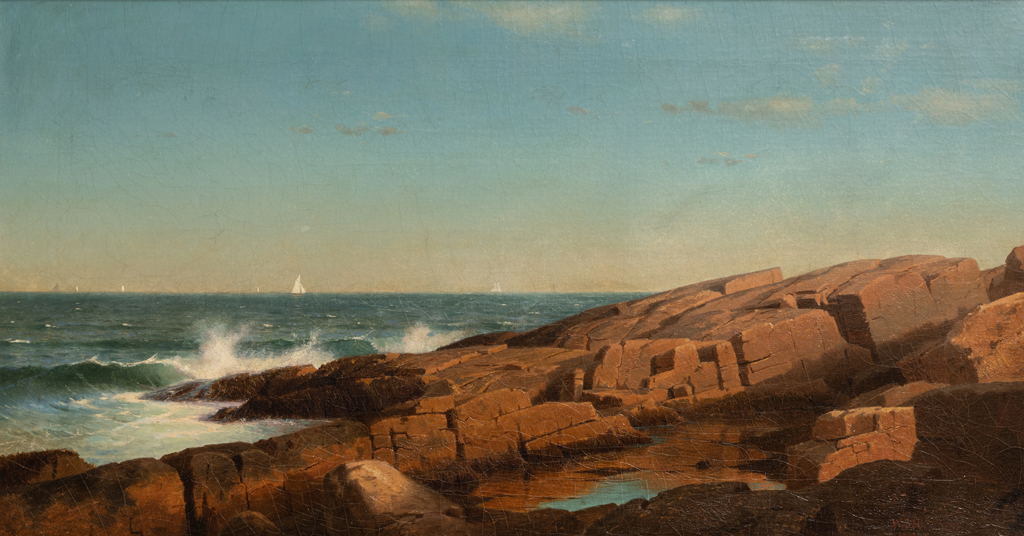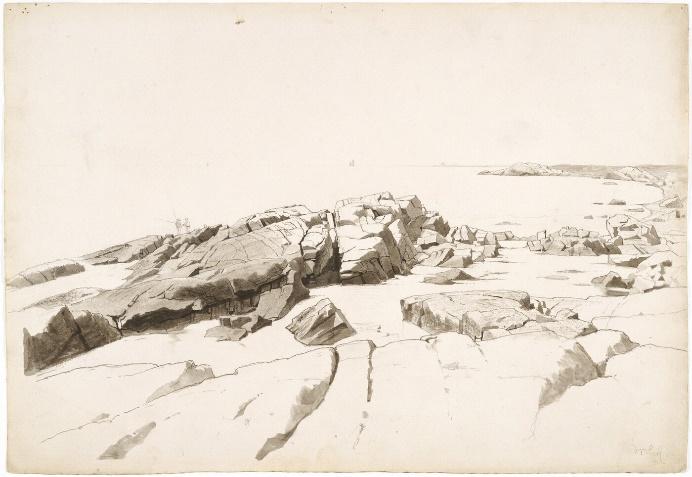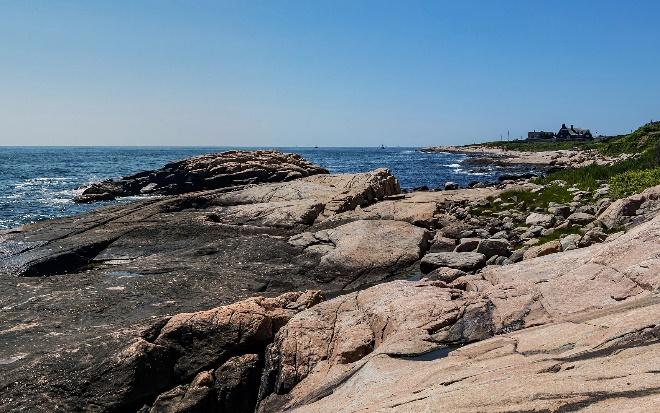
William Stanley Haseltine (1835–1900)
Rocks at Narragansett, 1863
Oil on canvas
McMullen Museum of Art, Boston College, Carolyn A. and Peter S. Lynch Collection, 2022.50

Jeffery Howe
Professor Emeritus, Art History

Haseltine spent the summers of 1862 and 1863 in Narragansett, Rhode Island, painting the rocky coast. Rocks at Narragansett depicts the site known as Indian Rock or Hazard Rock. Although the name Hazard Rock derives from the prominent Hazard family, it is known to fishermen as one the most dangerous places to fish in the United States. The exact location is confirmed by a related drawing that includes two fishermen (see image). The apparent flat expanse of rock is in fact the top of an underwater cavern, and the crashing waves create treacherous currents. The name Indian Rock also evokes Native legends and loss; as early as 1767 Narragansett tribal members lamented that all the land by the sea had been taken by the white colonists. The spectacular site was used for outdoor Episcopalian church services in the 1850s. In 1880 Rhode Island lawmakers declared the Narragansett extinct, seeking to erase them from the land.
Known for his precision and geologic accuracy, the artist captures a single moment and depicts the exact light of the sun hitting the rocks and reflecting off the water at that instant. Unlike his impressionist contemporaries, his work is clearly defined with a sharp realism. The eternal flux of the ocean is in tension with the seeming stasis of the rock, which nonetheless erodes with the waves. Art and science were seen as complementary by John Ruskin and many artists. Haseltine asserted that “every real artist is also a scientist, and scientists were also artists in the truest sense of the word.” Art historian Rebecca Bedell suggests that Haseltine may have been influenced by the popular public lectures on geological history given at Harvard by the now controversial scientist Louis Agassiz.


John Sallis
Frederick J. Adelmann, SJ Professor, Philosophy

Haseltine’s paintings are typical of the Hudson River school. As with most of the artists to whom this designation is applied, Haseltine established his reputation as a landscape painter. His paintings often drew from sketches of popular seaside resorts. Yet his most celebrated works were those portraying the rocky coast of New England. These “rock portraits” were geologically so precise that certain critics declared that they served both science and art. The southern coast of Rhode Island was among his favorite subjects, as in this depiction of rocks at a shore area around Narragansett. As with most of the works by artists of the Hudson River school, those of Haseltine display a close relationship with the natural elements and with the light and the configurations that bind them together. In Rocks at Narragansett it is the protrusion of the stones, appearing as though they emerged from the sea, that constitutes the primary subject. The pool splashing onto the rocks reflects the pale blue of the sky. These elements of nature—stones, water, sky—are thus bound together. The only sign of human presence in this natural setting are the sailboats far out at sea.
Ethan Baxter
Professor, Earth & Environmental Sciences

Haseltine’s Rocks at Narragansett depicts a classic rocky New England coastline, reminiscent of scenes from this spot in Rhode Island to the famous shores of Acadia National Park in Maine. The particular rock of these cliffs is granite, the product of molten magma coalescing and crystallizing slowly, deep within the Earth’s crust about 275 million years ago. This was the time of Pangea—the great supercontinent that unified all land onto a single mass, with modern day New England sandwiched in the middle. Granite’s well-formed interlocking crystals of quartz, feldspar, and a few other minerals give granite its strength. The feldspar takes on a brownish or even pinkish hue that gives it its color. And its slow cooling history gives it the distinctive rectangular blockiness formed by uniformly oriented contractional “joints” or “sheets” in the rocks. Upon closer inspection, sometimes those cracks served as conduits for hot fluids deep in the crust that can precipitate other minerals on those surfaces, like pistachio-green coatings of epidote. Now as the cooler water of the waves sweep across these rocky shores and into those cracks, the ocean itself can precipitate crystals of salt reflecting the modern surface ocean. Meanwhile, at the bottom of the rocks, we see indications of marine life (seaweed) establishing a foothold on the rock itself, sure to last as long as sea level maintains its current place. Finally, in the distance, we see the faint outlines of sailboats, evidence of another remarkable lifeform that has left its own mark on our remarkable planet. Artists like Haseltine have the opportunity to capture the stories of fire and water and life juxtaposed in these rocks and waves.
